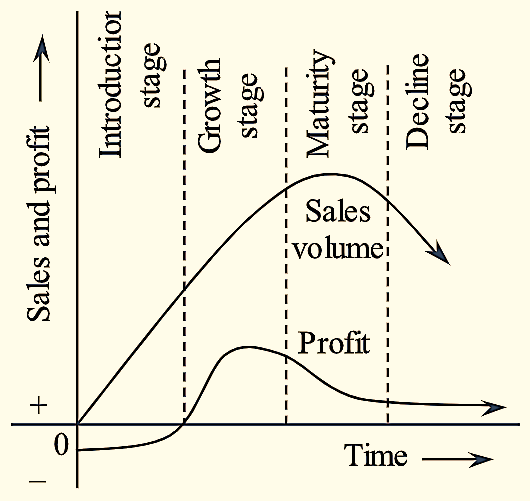The stages through which individual products pass through during a particular period of time is called as “product life-cycle”.
Stages of Product Life Cycle (PLC)
The product life cycle has four stages – Introduction, Growth, Maturity and Decline.

1. Introduction Stage
It is also called the ‘Pioneering Stage’. In this stage a new product is introduced in the market after it passes through product development, prototype and market tests.
It is the most risky and expensive stage as the firm has to incurs substantial research and development costs for developing the product and obtaining the acceptance of consumers. There are very less chances for the companies to earn profits on products at the introduction stage, as many new products are not accepted by customers and fail at this stage.
2. Growth Stage
It is also called ‘market-acceptance stage’. The growth stage is characterized by a rapid growth in sales and profits. Many competitors enter the market in this stage for earning profits. But, because of high competition in the market the profits are not stable and starts declining the end of this stage.
3. Maturity Stage
In this stage, sales volume increases at a decreasing rate. If the sales rate decreases then the producers and middlemen suffer losses because of intense price competition. For differentiating their products from other firms, the firms extend their product lines with new models or make use of new and ‘improved’ technologies for their existing brands. At the end of this stage, the marginal producers who incurred high cost and no differential advantage will exit from the market as they do not earn profits over the cost incurred and lost their customer’s attention towards their brand.
4. Decline Stage
This stage is characterized by the decline of the product due to new innovations leading to changes in the buying behaviour of consumers. In this stage, industry sales drop off and the number of competitors shrink. The following are some of the reasons for the decline of the product:
- A good and affordable product is introduced for satisfying the same need
- The product is no longer needed due to the development of other product
- Buyers are no longer interested in the product.
So, the product disappears from the market.
Necessity or Importance of Product Life Cycle (PLC)
The following points highlights the necessity and importance of Product Life Cycle (PLC),
- The product life cycle helps us to know the sales and profit volume of the product at various stages in its life.
- It also reflects the quality, features or characteristics of the product when compared to similar products in the market with respect to its price and market segmentation.
- It also keeps the marketing managers of the firms, alert so as to innovate new methods to improve the features, quality and low pricing of the product, stage wise. Thereby keeping a check on the efficiency of the organization.
- The product life cycle not only aims at sales and profit of the product but also aims at innovative strategies for the product by advertising distribution and sales promotion, hence maximizing the profits of the organization to a large extent.
- Akey advantage of PLC is that it keeps us aware of the products growth or decline, through which we can work out some measures to overcome in a short span of time challenges by competitor’s products.
- It can be used as a forecasting tool for planning and control.
Strategies of Product Life Cycle (PLC)
During decline stage, the aim is to minimize expenditure and to take advantage of brand for a longer stay in the market. Firms adopt different strategies to achieve this objective,
1. Providing Pruned Product Lines
To deal with the problem of decline in sales, firms reduce their product offers, phase out weak items and focus on mature products. Firms take these initiatives when they observe a shift in demand to new and advanced products.
2. Maintaining Stable Prices and Restoring to Price Cuts only when Unavoidable
Usually, prices remain the same due to the existence of some profitable segments and also few product competitors. If these segments don’t exits and customers exercise high bargaining power, then firms may opt for price cuts.
3. Reducing Promotion to the Minimum
Companies don’t launch even moderate level promotional campaigns when the sales fall and the market become detached to the product. As there exist some profitable market segments with hard-core loyal customers, there are chances of continuation of persuading and reminding promotional activities.
4. Selecting Specific Distributors
Firms attempt to convince distributors to continue keeping the product. To phase out unprofitable outlets, firm may also take some steps.
